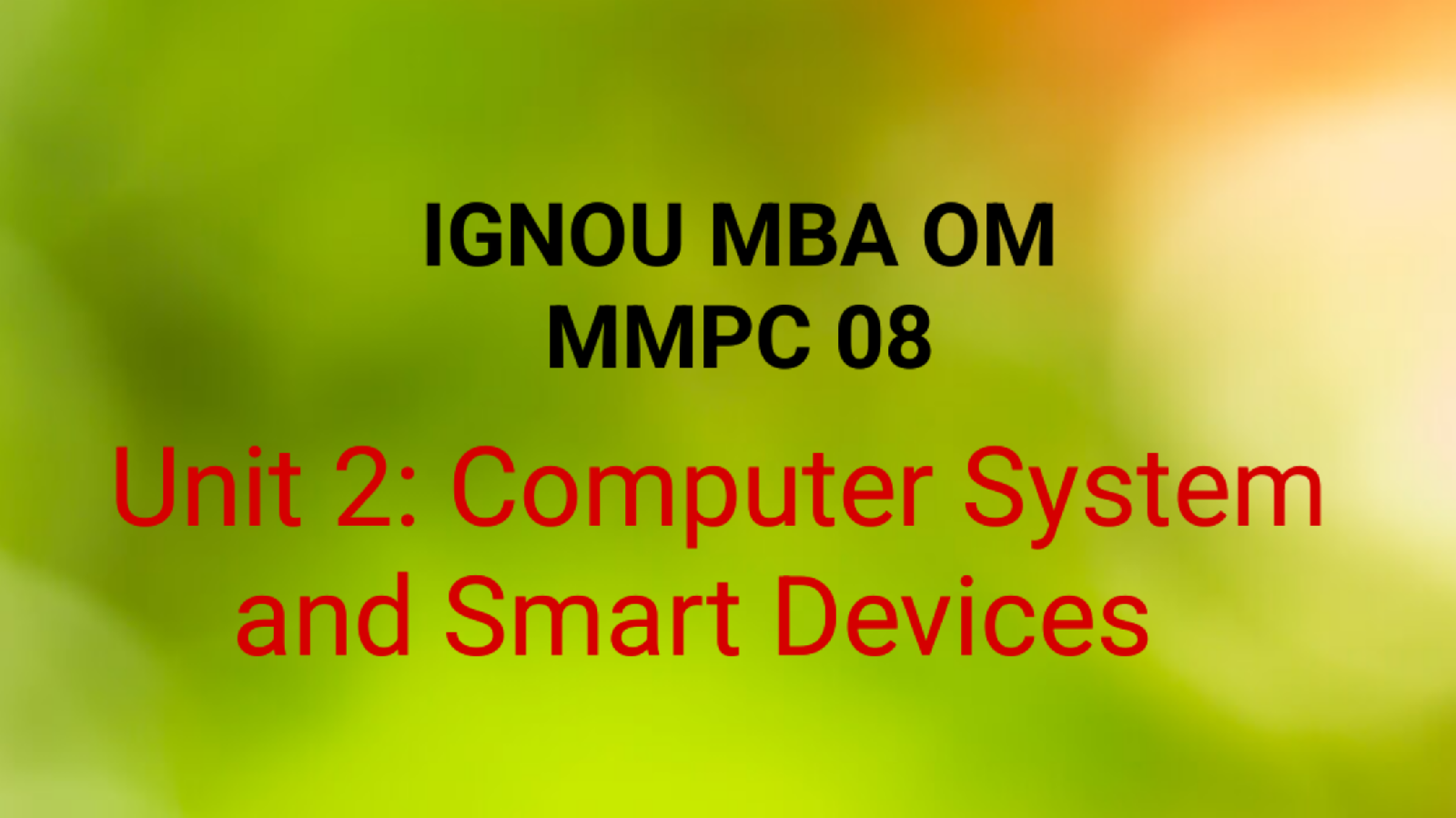IGNOU MBA MMPC-08: Information Technology for Managers
Unit 2: Computer System and Smart Devices
Introduction
A computer system is an essential component of modern business operations, supporting various applications and smart devices. This unit covers the architecture, functioning, and evolution of computer systems, along with an introduction to smart devices and their impact on business and daily life.
1. Computer System: Overview and Components
1.1 Definition of a Computer System
A computer system is a combination of hardware and software that processes data to generate meaningful output. It consists of input devices, a central processing unit (CPU), memory, storage, and output devices.
1.2 Components of a Computer System
- Hardware – The physical components, including:
- Input devices (keyboard, mouse, scanner)
- Output devices (monitor, printer, speakers)
- Central Processing Unit (CPU)
- Memory (RAM, ROM)
- Storage devices (HDD, SSD, USB drives)
- Networking components (routers, modems)
- Software – Programs that run on hardware, categorized as:
- System software (Operating Systems like Windows, Linux, macOS)
- Application software (MS Office, ERP, CRM tools)
- Utility software (Antivirus, Disk Cleanup, Backup tools)
1.3 Evolution of Computer Systems
- First Generation (1940s-1950s): Used vacuum tubes, large and expensive.
- Second Generation (1950s-1960s): Used transistors, smaller and more reliable.
- Third Generation (1960s-1970s): Used integrated circuits (ICs), enhanced speed and efficiency.
- Fourth Generation (1970s-1990s): Used microprocessors, led to personal computers (PCs).
- Fifth Generation (1990s-Present): AI-based computing, cloud computing, quantum computing.
1.4 Types of Computer Systems
- Supercomputers – High-performance computing for research and simulations.
- Mainframes – Used by large organizations for bulk data processing.
- Servers – Manage network resources and services.
- Personal Computers (PCs) – Used for personal and business tasks.
- Embedded Systems – Specialized systems in appliances, automobiles, and industrial machines.
2. Smart Devices and Their Applications
2.1 Introduction to Smart Devices
Smart devices are interconnected electronic devices that enhance productivity, automation, and communication. They use sensors, connectivity (Wi-Fi, Bluetooth), and artificial intelligence to provide intelligent functionalities.
2.2 Types of Smart Devices
- Smartphones – Multi-functional devices with computing, communication, and entertainment capabilities.
- Smartwatches – Wearable devices for fitness tracking, notifications, and health monitoring.
- Smart Home Devices – Includes smart lighting, thermostats, security cameras, and voice assistants.
- Smart TVs – Internet-connected televisions with streaming and interactive features.
- IoT-enabled Industrial Devices – Used in automation, supply chain management, and predictive maintenance.
2.3 Role of Smart Devices in Business and Daily Life
- Enhanced Connectivity: Facilitates seamless communication and collaboration.
- Automation and Efficiency: Reduces manual efforts in tasks like scheduling, monitoring, and controlling appliances.
- Data Collection and Analysis: Helps in decision-making through AI-driven insights.
- Health and Fitness Tracking: Improves well-being through smart health devices.
- E-commerce and Digital Payments: Facilitates online transactions and customer engagement.
3. Emerging Technologies in Computing and Smart Devices
3.1 Cloud Computing
Provides remote access to computing resources, reducing infrastructure costs and improving efficiency.
3.2 Artificial Intelligence (AI) and Machine Learning (ML)
Enables smart devices to learn from data and improve their performance over time.
3.3 Internet of Things (IoT)
Connects everyday objects to the internet for smart operations and real-time monitoring.
3.4 Blockchain Technology
Enhances security and transparency in smart contracts and digital transactions.
3.5 5G and Edge Computing
Boosts connectivity, enabling faster data transfer and low-latency smart device operations.
4. Practical Applications and Experiments
4.1 Experiment: Understanding Hardware Components
Objective: To identify and understand various computer hardware components.
Steps:
- Open a desktop or laptop system (if possible).
- Identify key components like CPU, RAM, HDD/SSD, motherboard, and power supply.
- Document their functions and importance in computing.
4.2 Experiment: Configuring a Smart Device
Objective: To explore the functionality of smart devices.
Steps:
- Connect a smart device (e.g., a smartwatch or smart speaker) to a smartphone.
- Configure basic settings like notifications, automation, and voice commands.
- Analyze the impact of smart devices on daily productivity.
5. Assignment Questions
- Explain the key components of a computer system with examples.
- How has the evolution of computer systems influenced business operations?
- Describe different types of computer systems and their applications.
- Discuss the role of smart devices in enhancing productivity and communication.
- How does AI and IoT contribute to the development of smart devices?
6. Self-Study Questions
- What are the major hardware and software components of a computer system?
- How do smart devices impact the healthcare industry?
- What are the differences between traditional computers and embedded systems?
- Explain the role of cloud computing in smart devices.
- How does 5G technology enhance the performance of smart devices?
7. Exam Questions
Short Answer Questions:
- Define a computer system.
- List the primary components of a CPU.
- What is the function of RAM in a computer?
- Name three smart home devices and their uses.
- Explain the role of AI in smart devices.
Long Answer Questions:
- Describe the evolution of computer systems from the first to the fifth generation.
- Compare and contrast different types of computer systems (supercomputers, mainframes, PCs, embedded systems).
- Explain the working of IoT-enabled smart devices with real-world examples.
- Discuss the advantages and challenges of using smart devices in business environments.
- How does blockchain technology enhance security in smart devices?
Conclusion
This unit provides a comprehensive understanding of computer systems and smart devices, including their components, evolution, and applications in various domains. The integration of emerging technologies like AI, IoT, and cloud computing has revolutionized the way businesses and individuals use IT resources.
This document covers Unit 2: Computer System and Smart Devices for IGNOU MBA MMPC-08 in detail, including theories, experiments, assignment questions, self-study questions, and exam questions. Let me know if you need any modifications or additional explanations!





















